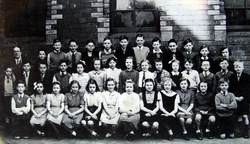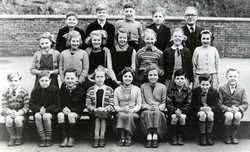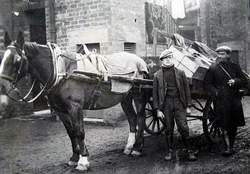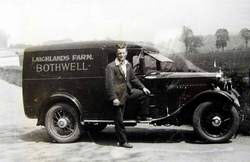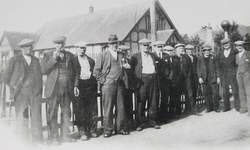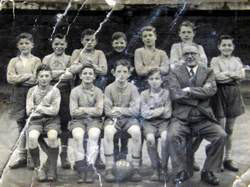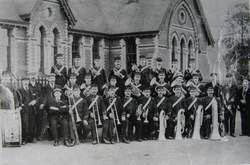Abandoned Communities ..... Bothwellhaugh
A small school was opened at Bothwellhaugh soon after the mines opened. It was extended in 1902 by the Bothwell School Board, but continued to be overcrowded, especially during World War I, when pupil numbers rose to over 500. In 1909 the school received a highly unfavourable report from His Majesty’s Inspector of Schools. There were not enough desks or classroom space, and too few permanent teaching staff. The physical environment left a lot to be desired as the school was located next to one of the mine dumps and close to the noise and distractions of the pithead workings and the railway sidings. The Inspector recommended that the Bothwell School Board should be penalised by the loss of part of its annual grant.
A further hazard posed by the mine dump was that it would occasionally catch fire and might continue to burn for several weeks. Anyone at the school would then be aware of strong smells and noxious fumes.
From time to time attendance at the school was affected by illness. In September 1903 the school was closed for two weeks during an epidemic of measles. When it re-opened half of the pupils were still absent, and the decision was take to close it again for a further two weeks. Absence from school was especially high during 1911, when the village was affected by epidemics of scarlet fever, diphtheria, and measles.
There was also a Roman Catholic primary school, St Bride’s. In the early 1960s pupils leaving St Bride’s might go on to St.Saviour's High School, Bellshill.
Outside school boys were encouraged to join the Bothwellhaugh troop of the Boy Scouts. By the 1920s, however, the Boys Brigade seems to have been more popular, possibly because it offered more sporting activities and because it was less rigid in requiring a full uniform. Girls could join the Girl Guides, who went on an annual camp and took part in fund raising events such as whist drives and fancy dress parades.
Robert Duncan has described the various ways in which the Bent Colliery Company attempted to guide the leisure and social activities of the people of Bothwellhaugh. The sale of alcohol in the village was banned, and gambling strongly discouraged. In 1915 two men were prosecuted for illegal betting. One of them, Francis McKenna, who had a previous conviction for receiving bets, was fined £20 for contravention of the Street Betting Act. In August 1924 the company opened a large Miners Welfare Institute, comprising a hall, reading room, smoking room, kitchen, and baths. At first miners avoided the Institute, but it became more popular when regular film shows began. A few years later an extension was added that included a billiards room, a room for carpet bowls, and another games room.
Other popular leisure activities included dog racing, pigeon racing, playing in bands, and gardening. Near the end of World War I an area was set aside for allotments, part of a general move by the government to deal with wartime shortages by encouraging people to grow their own vegetables.
At different times a number of shops existed in Bothwellhaugh, and in addition deliveries were made to houses by traders from neighbouring towns. Elizabeth and William Mair, who lived at 1 Haugh Place, turned their front room into a shop known as “Mair’s shop”. As it was near the pit gate a lot of the men would call in for their “pieces” on their way to work. They would buy on tick and then settle up when they got their wages. Another favourite place for shopping was the Co-operative store. The Hamilton Palace Colliery Co-operative Society was created in 1886, set up by local miners independently of the company. By 1919 it had 600 members, with an unusually high dividend of 3 shillings in the pound. At that time 26 staff were employed in the Co-op.
A further hazard posed by the mine dump was that it would occasionally catch fire and might continue to burn for several weeks. Anyone at the school would then be aware of strong smells and noxious fumes.
From time to time attendance at the school was affected by illness. In September 1903 the school was closed for two weeks during an epidemic of measles. When it re-
There was also a Roman Catholic primary school, St Bride’s. In the early 1960s pupils leaving St Bride’s might go on to St.Saviour's High School, Bellshill.
Outside school boys were encouraged to join the Bothwellhaugh troop of the Boy Scouts. By the 1920s, however, the Boys Brigade seems to have been more popular, possibly because it offered more sporting activities and because it was less rigid in requiring a full uniform. Girls could join the Girl Guides, who went on an annual camp and took part in fund raising events such as whist drives and fancy dress parades.
Robert Duncan has described the various ways in which the Bent Colliery Company attempted to guide the leisure and social activities of the people of Bothwellhaugh. The sale of alcohol in the village was banned, and gambling strongly discouraged. In 1915 two men were prosecuted for illegal betting. One of them, Francis McKenna, who had a previous conviction for receiving bets, was fined £20 for contravention of the Street Betting Act. In August 1924 the company opened a large Miners Welfare Institute, comprising a hall, reading room, smoking room, kitchen, and baths. At first miners avoided the Institute, but it became more popular when regular film shows began. A few years later an extension was added that included a billiards room, a room for carpet bowls, and another games room.
Other popular leisure activities included dog racing, pigeon racing, playing in bands, and gardening. Near the end of World War I an area was set aside for allotments, part of a general move by the government to deal with wartime shortages by encouraging people to grow their own vegetables.
At different times a number of shops existed in Bothwellhaugh, and in addition deliveries were made to houses by traders from neighbouring towns. Elizabeth and William Mair, who lived at 1 Haugh Place, turned their front room into a shop known as “Mair’s shop”. As it was near the pit gate a lot of the men would call in for their “pieces” on their way to work. They would buy on tick and then settle up when they got their wages. Another favourite place for shopping was the Co-
Three
A school photograph in 1944
If you want to know the names of any individuals in a group photograph I may be able to supply them
A school photograph in 1953
Andrew Simpson delivering fruit and vegetables
George Murie delivering milk
A group of retired men outside the Memorial Church. Fourth from the left, wearing a trilby hat, is Robert Lang, colliery manager until he retired in 1930.
A school football team, 1955. Please note (a) hairstyles, (b) socks.
Bothwellhaugh silver band
